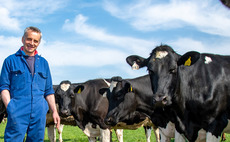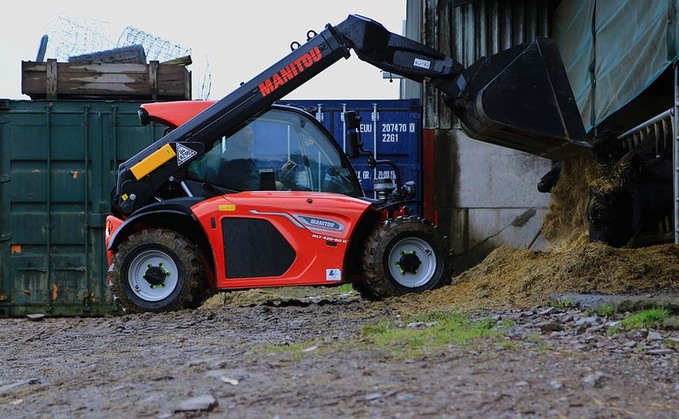
For one Dumfriesshire farmer and contractor, switching from a skid steer to a compact telehandler has enabled more operations to be completed without sacrificing usability when space is at a premium. Alex Heath reports.
With tight passageways to negotiate each day and the realisation of skid steer limitations, Gregory Bowran of Terregles, near Dumfries last year decided the time was right to invest in a compact telehandler.
"We have always been fans of skid steers, having run 10 in years gone by, however, with the latest to arrive not reaching our expectations and the contracting business growing, we decided that a Manitou MLT 420-60 H was the solution we had been looking for."
The 101-hectare farm is home to 90 suckler cows with progeny taken through to slaughter, in addition to a contracting business under the name of M T Bowran. The predominantly Simmental bred cows and followers, which equate to 260 head at certain parts of the year, are housed during the winter, with narrow passageways for feeding and scraping, limiting the size of machine the farm can use.
The farm makes all its own silage, mainly ensiled in a pit, however, some bales are also made for themselves and customers, using two Mchale F5500 balers and an Orbital wrapper.
Mr Bowran says: "It got to the point with the skid steers that too many jobs could not be done in-house, including lifting bales from fields and loading the grain mill and high sided trailers, requiring another contractor with a telehandler to come in and help. We were pushing the machines to their capacity limits, especially when moving bales or unloading fertiliser where we needed an experienced operator to do such tasks.
"The latest machine we had on farm had electronic controls, which were incredibly difficult to operate with any subtly, as there was no feed back to the operator. And with a series of control issues, as the memory on the machine did not hold onto the programming information, we decided to move it on.
"Local dealer Lloyds, where the skid steer came from suggested we looked at a compact telehandler and gave us a demo of Manitou's MT 420 H, which is the construction version. We liked the size of the machine, it could get most places the skid could and had extra lifting capacity and reach. However, being a construction machine, it was not designed to be run continuously, especially when running a grab for instance. The oil soon started over heating, ruling it out for us. That led us to look at other makes, but then Manitou launched the agri-version, with larger cooling pack."
Purchased in the autumn of 2020, the telehandler has already racked up 450 hours, with Mr Bowran expecting to place 100 hours per month on the machine.
Capable of lifting 2,000kg, Mr Bowran says it has no problem lifting two bags of fertiliser from a lorry, or handling the farm's silage bales, typically 1,000kg in weight. Being a narrow machine, he says respect must be shown when the boom is fully extended while turning, but remarks the telehandler is surprisingly stable for such a small machine, which measures 1,490mm wide.
Shod on 305/70-16.5 industrial type tyres, he says the farm will look at another wider set of tyres when field work recommences, but for around the yard, they are hard to beat and combined with the telehandler, offer additional savings.
"We would expect to get about 500 hours out of a set of tyres on the skid steer, but they were prone to rips and unseating themselves from the bead when skewing around on the yard, which is not the smoothest of concrete. The tyres on the telehandler look barely worn in, but we need a wider set when carting silage," he adds.
With space on his farm and those of customers at such a premium, Mr Bowran was apprehensive about the loader's manoeuvrability, but his fears were soon abated.
"It will get near enough anywhere the skid steers would have. It is the same width, a shade lower, but significantly longer. For straight runs down a shed it is spot on. We have lost just two contracts on farms where a 90 degree turn is needed to access sheds, which the telehandler cannot do, but work rates are comparable.
"When filling trailers, for example, a skid steer gains in speed of manoeuvring, but the trailer needs to be close by. However, the telehandler gains in the amount it can lift each time, meaning the trailer can be further away and still be loaded quicker. Also, it is much easier as you have a better view of the bucket and are not wedged against the trailer as you are with a skid steer, making it safer and a more pleasant job," he comments.
The telehandler features a well appointed cab, according to Mr Bowran, which features all the niceties you would expect on a larger machine and nearly the same size, too.
"When we looked at other machines, the cabs seemed cramped and narrow and many of them were very basic, having stripped any luxuries, such as the heater, radio and joystick functions out of them. This cab is spacious and features Manitou's JSM joystick, which we get on really well with.
"Visibility is also excellent, especially at the back; you can pretty much see the rear wheel on the other side. The rear-end is so compact; it is easy to back right up to a wall without needing a mirror to see how close you are. The boom also sits very low," he says.
One feature Mr Bowran would have liked to see on the machine is boom suspension, commenting it can be slightly rough when traversing a broken-up yard, causing feed to be shaken out of the bucket. In addition, he would like to see a bigger hydraulic pump that requires less coaxing to perform. However, with a bit of throttle he says operations are swift enough, although one or two functions at a time are all that can be used.
"When loading, it struggles to boom out, lift and tip all at the same time. However, you get used to operating the functions in sequence, such as boom up first, then boom extend, followed by tipping and opening of the grab.
"It is significantly quicker lowering and retracting, though. We have had the oil temp rise a couple of times, but a flick of the reverse fan and it drops straight back down," he reports.
LED lighting features on the top of the roof, which Mr Bowran describes as having ‘unreal power'. Standard bulb lights are used as low-level headlights but are not in the ideal position, situated on the front of the mudguards and susceptible to being caught on trailers if care is not taken, he says.
Other features that have impressed Mr Bowran include the third service depressurisation button outside the cab: "On the skid steers, operators would try and find someone else to disconnect pipes when changing attachments. Now it is simple, press the button and all pressure is released from the attachment. I also like how the radiator folds for easy cleaning, from the engine bay, which has everything shoehorned into it," he comments.
The Kubota, four-cylinder engine has plenty of power and has been no thirstier than the skid steers, says Mr Bowran. He also commends the hydrostatic transmission's ease of use and responsiveness.
Overall, Mr Bowran says the telehandler is a big improvement on skid steers, offering similar manoeuvrability credentials but allowing greater weights to be lifted to increased heights, cutting his reliance on outside help.

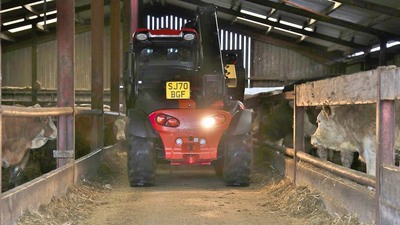
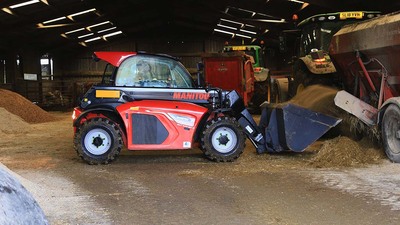

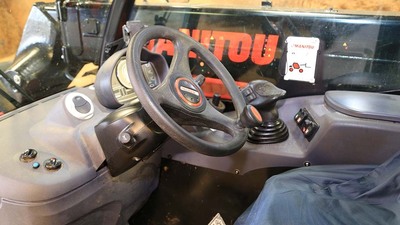
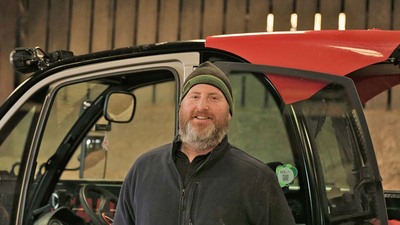
Verdict
Mr Bowran is impressed with the manoeuvrability of the Manitou MLT 420-60 H compact telehandler, stating it gets nearly everywhere a skid steer would. However, the big advantage over a skid steer is the amount of weight and height to which the telehandler can lift.
With 450 hours registered so far, he says the cab is well appointed and comfortable. Nice features like the outside third service depressurisation button, reversing fan and LED lighting make the loader user friendly.

















